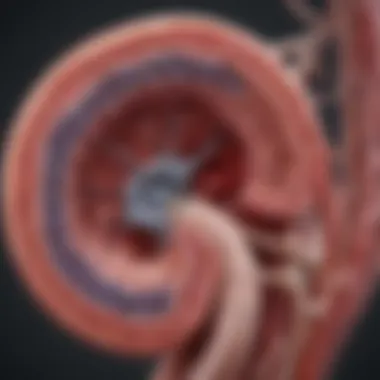Understanding Glomerular Filtration Rate for Kidney Health


Intro
Glomerular filtration rate, commonly known as GFR, is a critical measure of kidney function and overall health. It indicates how effectively the kidneys filter blood, removing waste and excess substances. A normal GFR shows that the kidneys are performing adequately, an essential aspect of maintaining bodily homeostasis. Understanding GFR allows healthcare professionals to diagnose and monitor various renal conditions.
The significance of GFR extends beyond mere numbers; it has implications for patient management and treatment. Monitoring GFR can help assess the risk of kidney diseases and guide decisions regarding interventions. This article will delve into the intricate details of GFR, discuss its measurement techniques, and highlight the factors influencing its value. Additionally, we will explore the clinical applications of GFR assessments and their relevance in current medicine.
Research Overview
Summary of Key Findings
Research indicates that GFR is not just a static measure but can vary depending on several factors such as age, sex, body size, and even the presence of comorbidities like diabetes or hypertension. Studies have shown that it serves as an essential prognostic indicator in many chronic kidney diseases. A declining GFR often signals an escalating risk for cardiovascular incidents, reinforcing the importance of routine assessments.
Importance of the Research
Understanding GFR helps in the early detection of kidney dysfunction. Effective screening and monitoring through precise GFR calculations can lead to interventions that slow disease progression. Furthermore, it aids in tailoring treatment options for patients, ensuring personalized medical care.
Methodology
Study Design
Most research on GFR employs retrospective analyses of clinical data. Evaluating historical medical records allows researchers to understand how GFR impacts outcomes over time. This approach has paved the way for longitudinal studies that offer insights into how various treatments affect kidney function.
Data Collection Techniques
Data collection varies according to the study's focus. Common techniques include:
- Creatinine Clearance Test: A traditional method for estimating GFR, involving timed urine collection and blood tests.
- Chronic Kidney Disease Epidemiology Collaboration (CKD-EPI) equation: A widely accepted formula that uses serum creatinine, age, and sex to estimate GFR more accurately.
Collecting data through both methods enhances the reliability and validity of GFR assessments, making it a cornerstone in nephrology research.
Preamble to Glomerular Filtration Rate
Understanding the glomerular filtration rate (GFR) is central to nephrology and renal physiology. GFR serves as a critical indicator of kidney function and can reveal much about an individual's overall health. This introductory section sets the stage for a more comprehensive examination of GFR by explaining its definition and highlighting its significance in renal physiology.
Definition of Glomerular Filtration Rate
The glomerular filtration rate refers to the volume of fluid filtered from the renal glomerular capillaries into the Bowman’s capsule per unit time. It is typically measured in milliliters per minute. GFR represents the kidneys' filtering capability and is essential for maintaining the body’s homeostasis. The measurement of GFR is key for determining how well the kidneys are functioning in terms of waste elimination and metabolic regulation.
GFR can be calculated using various formulas but is often directly measured through the clearance of substances known to be filtered by the kidneys, such as creatinine, in the blood. The normal GFR value for a healthy adult generally ranges from 90 to 120 mL/min. However, normal phenomena such as aging can affect GFR.
Importance of GFR in Renal Physiology
GFR is vital for various physiological functions within the kidneys. Firstly, it provides insight into renal health, as changes in GFR can indicate early signs of kidney disease. A decline in GFR may suggest glomerular injury or renal impairment, necessitating further diagnostic evaluation.
Furthermore, GFR plays an essential role in the regulation of fluid and electrolyte balance. The kidneys filter blood, remove excess solutes and body wastes, while reabsorbing necessary substances back into the bloodstream. This process helps maintain the acid-base balance and blood pressure regulation.
Moreover, understanding GFR allows healthcare providers to make more informed decisions regarding medication dosing. Many medications are cleared through the kidneys, and knowing the GFR can ensure that dosages are adjusted appropriately to prevent toxicity or therapeutic failure.
In summary, GFR is a cornerstone concept in renal physiology. Its understanding is not only academic but translates into practical implications for patient care.
"Monitoring glomerular filtration rate is crucial for early detection of renal abnormalities."
By grasping the importance of GFR in the context of kidney function, medical professionals can better navigate the complex interplay of renal health and disease.
Physiological Mechanisms of GFR
Understanding the physiological mechanisms behind glomerular filtration rate (GFR) is essential for comprehending kidney function. GFR reflects the kidneys’ ability to filter blood and remove waste products. This section explores the anatomical and functional aspects contributing to GFR, emphasizing the critical balance between the body’s necessity for waste removal and maintaining fluid and electrolyte homeostasis.


Anatomy of the Glomerulus
The glomerulus is a network of capillaries located at the beginning of each nephron. Its unique structure is pivotal for GFR. The afferent arteriole brings blood into the glomerulus, while the efferent arteriole carries blood away. The high surface area provided by the convoluted shape of the capillaries allows for efficient filtration.
The glomerular capillaries are further encased by Bowman's capsule. This capsule plays a vital role in collecting the filtrate as blood passes through the capillaries. The thin walls of the capillaries, alongside the proximity to Bowman's capsule, maximize filtration efficiency. Understanding this anatomy is crucial, as alterations in any component can impact GFR.
Filtration Barrier Components
The filtration barrier is made up of three main layers: the endothelial cells of the capillaries, the basement membrane, and the podocytes, which are specialized epithelial cells.
- Endothelial Cells: These cells have fenestrations that allow water and small solutes to pass while restricting larger molecules like proteins from entering the filtrate.
- Basement Membrane: This serves as a supportive layer and also acts as a filtration barrier due to its negative charge, which repels negatively charged molecules such as albumin.
- Podocytes: These cells have foot-like processes (pedicels) that wrap around the capillaries, providing additional filtration control.
The integrity and functionality of this barrier are paramount. Damages or mutations in any of these components can lead to increased permeability, which may result in proteinuria and other pathologies.
Regulation of Glomerular Filtration
Regulation of GFR is a multifaceted process that involves neural, hormonal, and intrinsic mechanisms. Understanding these mechanisms offers insight into how the kidneys maintain homeostasis.
- Autoregulation: The kidneys can adjust their own blood flow through the myogenic response. When blood pressure rises, the afferent arteriole constricts to reduce blood flow, thus maintaining GFR. Conversely, if blood pressure drops, the arteriole dilates, allowing more blood in.
- Neurotransmitters: The sympathetic nervous system can influence GFR. In times of stress, vasoconstriction occurs, prioritizing blood flow to vital organs over the kidneys.
- Hormonal Control: Hormones such as angiotensin II and atrial natriuretic peptide play crucial roles. Angiotensin II constricts the efferent arteriole to maintain GFR during low blood pressure, while atrial natriuretic peptide promotes vasodilation, resulting in increased GFR.
Understanding these regulations highlights the adaptability of the renal system under various physiological conditions. Each mechanism contributes to a fine-tuned balance necessary for proper kidney function.
The intricacies of the glomerulus and its regulation significantly determine the efficiency of glomerular filtration, influencing overall metabolic homeostasis.
Factors Influencing GFR
Understanding the factors that influence glomerular filtration rate (GFR) is crucial in comprehending kidney function and health. GFR not only serves as a key indicator in diagnosing renal diseases but also provides insights into the body's overall homeostasis. Anomalies in GFR can reflect alterations in systemic hemodynamics, fluid status, and hormonal influences, thereby calling for an analytical approach to evaluate its determinants.
Hydrostatic Pressure in the Glomerulus
Hydrostatic pressure within the glomerulus is a primary driver for filtration. This pressure is generated by blood flow from the afferent arteriole into the glomerular capillaries. A higher hydrostatic pressure facilitates a greater filtration rate, while any obstruction or decrease in pressure can lead to reduced GFR.
Factors such as vascular resistance and blood volume significantly affect this hydrostatic pressure. For instance, increased blood volume raises the pressure in the glomerular capillaries, consequently bolstering the GFR. Changes in vascular tone, such as during stress or disease, can also alter hydrostatic pressure, thus influencing kidney function.
Oncotic Pressure and its Effect
Oncotic pressure is the opposing force to hydrostatic pressure. It is primarily determined by proteins like albumin in the blood plasma. Elevated oncotic pressure hinders fluid movement into the nephron, lowering GFR. In contrast, a decrease in oncotic pressure, whether due to liver dysfunction or nephrotic syndrome, enhances the filtration process, potentially leading to an increased GFR.
Consequently, maintaining a balance between hydrostatic and oncotic pressures is necessary for optimal kidney performance. Clinicians often monitor serum albumin levels and other proteins to evaluate their impact on renal function.
Impact of Blood Volume and Flow
The overall blood volume and its flow determine the amount of fluid entering the kidneys. An increase in blood volume typically correlates with increased GFR due to enhanced perfusion. Conversely, when blood volume decreases—like in dehydration or hemorrhage—GFR declines as well, leading to compromised kidney function.
Additionally, blood flow distribution to the kidneys can be affected by various factors, including sympathetic nervous system activity and systemic vascular resistance. An unexpected reduction in renal blood flow can often precede acute kidney injury, highlighting the importance of blood volume and flow in renal health assessment.
Hormonal Regulation of GFR
Hormonal factors play a critical role in the regulation of GFR. The renin-angiotensin-aldosterone system (RAAS) is particularly significant. When blood flow to the kidneys decreases, juxtaglomerular cells release renin, initiating the conversion of angiotensinogen to angiotensin I, which eventually leads to the production of angiotensin II. This hormone constricts efferent arterioles and also influences blood pressure, increasing GFR.
Additionally, hormones like atrial natriuretic peptide exert an opposing effect, facilitating vasodilation and increasing GFR during instances of volume overload. Therefore, assessing hormonal levels can provide insights into renal health and function.
Overall, the interplay of hydrostatic and oncotic pressures, blood volume, flow dynamics, and hormonal influences form a complex network that governs GFR. Understanding these factors is essential for both clinical practice and ongoing research into kidney health.
Measurement of GFR
The measurement of glomerular filtration rate (GFR) serves a pivotal role in understanding kidney function. It allows clinicians and researchers to assess a person's renal health and the efficiency of the kidneys in filtering waste products from the blood. Accurate measurement of GFR is crucial in diagnosing various stages of kidney disease and determining appropriate treatment options. Moreover, it helps in monitoring the progression of renal conditions over time, ultimately influencing patient outcomes.
Each method for measuring GFR has its own advantages and concerns, impacting clinical decisions. Understanding the various techniques available becomes essential not just for nephrologists but also for general practitioners who manage patients with kidney-related issues. An insight into these methods highlights the dynamic nature of diagnosing renal function and reflects on advancements in medical technology.


Traditional Methods of Measuring GFR
Historically, the most established method for determining GFR involves the clearance of creatinine from the blood. Creatinine is a byproduct of muscle metabolism and is filtered by the kidneys. To estimate GFR via creatinine clearance, a 24-hour urine sample is collected along with a blood sample.
- Advantages of Creatinine Clearance:
- Limitations:
- Easy and inexpensive to perform.
- Non-invasive once the urine is collected.
- Requires full 24-hour urine collection, which can affect accuracy.
- Factors like diet and muscle mass can influence creatinine levels and thus GFR estimation.
In addition to creatinine clearance, another popular method has been the use of inulin clearance. Inulin, a fructose polysaccharide, provides a more accurate GFR measurement since it is freely filtered and not secreted or reabsorbed by the kidneys.
Modern Techniques and Technologies
Recent advancements have led to more precise measures of GFR due to sophisticated technologies. One promising technique involves the use of radioisotope GFR measurements. This method utilizes radiolabeled compounds, such as technetium-99m DTPA, which track renal blood flow and filtration.
"Novel imaging technologies provide enhanced accuracy in assessing renal function compared to traditional methods."
Another approach is the application of dual-energy X-ray absorptiometry (DEXA), which helps in evaluating kidney anatomy and function in relation to GFR. Furthermore, the development of MRI and CT imaging has also opened new pathways for understanding kidney filtration dynamics in real time.
Estimation Equations for GFR
As a practical alternative to direct measurement, several equations have been formulated to estimate GFR based on serum creatinine levels, age, sex, and body weight. The Modification of Diet in Renal Disease (MDRD) equation and the Chronic Kidney Disease Epidemiology Collaboration (CKD-EPI) equation are widely used today in clinical practice.
- MDRD Equation:
- CKD-EPI Equation:
- Mainly used for patients with chronic kidney disease.
- Can underestimate GFR in those with near-normal renal function.
- More accurate across a wider range of kidney function.
- Preferred for general population estimates above 60 mL/min/1.73 m².
These estimation formulas simplify the process of assessing renal function, but they need to be interpreted carefully, especially in populations with varied characteristics.
Clinical Relevance of GFR
The clinical relevance of glomerular filtration rate (GFR) cannot be overstated. It plays a pivotal role in assessing kidney health and function. GFR serves as a cornerstone for diagnosing various renal diseases, framing treatment approaches, and guiding medication adjustments. Understanding GFR is essential for both practitioners and patients alike, as it informs clinical decisions and impacts patient outcomes.
GFR in Diagnosing Kidney Disease
GFR is an invaluable metric in the diagnosis of kidney disease. A decrease in GFR often indicates impaired renal function, which can be symptomatic of chronic kidney disease (CKD), acute kidney injury (AKI), or other pathologies. By measuring GFR, healthcare professionals can differentiate between various forms of kidney dysfunction, allowing for a targeted diagnostic approach.
- Early Detection: Early identification of reduced GFR levels is crucial for prompt intervention. Detecting renal impairment at earlier stages can prevent further progression, which significantly improves patient prognosis.
- Risk Stratification: GFR allows for stratifying patients based on risk. For instance, individuals with a GFR under 60 mL/min/1.73 m² are at a higher risk for cardiovascular complications, emphasizing the need for careful monitoring.
- Identification of Etiology: Using GFR alongside other tests, such as imaging or urinalysis, helps identify the underlying etiology of renal impairment.
GFR and Chronic Kidney Disease Staging
Chronic kidney disease is classified into stages based largely on GFR values. Each stage corresponds to the degree of kidney dysfunction, which guides management strategies and patient education.
- Stage Classification: The Kidney Disease: Improving Global Outcomes (KDIGO) framework outlines CKD stages, ranging from Stage 1 (normal or high GFR) to Stage 5 (kidney failure). This classification allows for tailored treatment plans based on stage-specific needs.
- Monitoring Progression: Regular monitoring of GFR can help predict disease progression. A stable or improving GFR may indicate effective management, whereas declining GFR may signal the necessity of more aggressive interventions.
- Treatment Decisions: Treatment plans, including dietary modifications and pharmacotherapy, often depend on the CKD stage determined by GFR values. Clinicians can engage patients meaningfully in their care by explaining how GFR informs treatment decisions.
Implications of GFR in Medication Dosing
GFR assessment is critical for determining appropriate medication dosing. Many drugs are renally excreted, and their efficacy and safety can be significantly influenced by kidney function.
- Dose Adjustments Needed: Patients with reduced GFR often require dose adjustments to avoid toxicity. Medications such as digoxin, aminoglycosides, and certain antibiotics must be carefully dosed based on estimated GFR values to prevent adverse outcomes.
- Assessment of Accumulation Risk: Evaluating GFR helps predict the risk of drug accumulation, which is crucial for medications that have narrow therapeutic indices.
- Guidelines and Recommendations: Comprehensive guidelines, such as those from the National Kidney Foundation, advocate for utilizing GFR in medication management, reinforcing the integration of renal function assessments into routine clinical practice.
GFR measurements play an essential role not only in diagnosing but also in appropriately treating patients with kidney disease, underlining its importance in clinical practice.
Limitations of GFR Assessments


Assessing glomerular filtration rate (GFR) is essential for understanding kidney function and diagnosing kidney diseases. However, there are several limitations associated with GFR assessments that healthcare professionals must be aware of. Recognizing these factors is crucial for making informed decisions regarding patient care and treatment.
Factors Leading to GFR Misestimation
GFR assessments can often lead to misestimations. Several factors contribute to this phenomenon. One significant element is the choice of the method employed for measurement. Traditional methods, such as creatinine clearance, rely on the collection of urine over a specified period which can be prone to errors due to incomplete collection. Situational factors, such as hydration status, can also skew results. For instance, dehydration can result in higher creatinine levels, suggesting a lowered GFR when the kidney function is actually normal.
Key factors influencing GFR misestimation include:
- Patients' Age: As people age, muscle mass typically decreases, resulting in lower creatinine production. This may misrepresent kidney function.
- Muscle Mass Variability: Individuals with higher muscle mass may show elevated creatinine levels, while those with low muscle mass might have lower levels despite reduced kidney function.
- Dietary Influences: High protein diets can elevate blood urea nitrogen levels, misleading GFR interpretations.
It is vital for practitioners to consider these aspects when interpreting GFR results to avoid misleading conclusions about a patient's renal function.
Variability in Population Studies
Population studies provide valuable insights into GFR ranges and interpretations. However, the inherent variability within these studies is a significant limitation. Different populations may exhibit distinct physiological traits influencing kidney function. For instance, ethnic backgrounds often correlate with variations in baseline kidney function, which can skew national averages.
Furthermore, external factors such as geographic location and socio-economic conditions may contribute to differing kidney health across populations.
Studies often find that factors such as diet, lifestyle, and access to healthcare can dramatically affect average GFR readings among different groups.
Significant reasons for variability include:
- Sample Size Limitations: Smaller population samples may not accurately reflect a broader demographic.
- Selection Bias: Non-representative samples can lead to discrepancies in GFR estimates.
- Differences in Measurement Techniques: Variability in measurement methods can create inconsistencies in reported data.
Understanding these limitations in population studies is essential for researchers and clinicians to develop appropriate clinical guidelines.
In summary, while GFR assessments provide critical insights into kidney health, professionals should be cautious of the factors that may lead to misestimation and the variability inherent in population studies. Addressing these limitations can improve the accuracy of GFR monitoring and enhance patient outcomes.
Future Directions in GFR Research
The future of glomerular filtration rate (GFR) research is pivotal for enhancing our understanding of renal health and diseases. The landscape is evolving rapidly, driven by advancements in medical science and technology. Focus on GFR has far-reaching implications not just for diagnosis, but also for treatment strategies that can improve patient outcomes. The ongoing quest for precise and accessible methods to assess GFR is fundamental.
Advances in Biomarkers for GFR Testing
Recent research highlights the emergence of novel biomarkers that could revolutionize GFR testing. The traditional reliance on serum creatinine levels has significant limitations. New markers such as cystatin C and beta-2 microglobulin show potential to provide a more accurate reflection of renal function. These biomarkers could lead to earlier detection of kidney dysfunction, allowing for timely intervention.
From a research perspective, the continual validation of these biomarkers in diverse populations is crucial. Each biomarker must undergo rigorous testing to ensure reliability and reproducibility in various clinical settings. This ongoing scrutiny will enhance clinical guidelines regarding GFR assessments, making them more tailored to individual patient needs.
Integration of GFR into Digital Health
The integration of GFR assessment into digital health platforms is gaining traction. As telemedicine and mobile health applications become more prevalent, there is an opportunity to leverage technology for monitoring renal health. Devices that track patient data in real-time can provide vital insights into GFR fluctuations, improving management of chronic kidney disease.
Additionally, implementing machine learning algorithms can enhance predictive analytics related to renal function. Such integration promotes a proactive instead of reactive approach, enabling healthcare providers to make data-driven decisions. This evolution creates a more personalized care pathway for patients, further emphasizing the importance of GFR as a key health indicator.
Potential for Gene Therapy in Renal Function
Gene therapy represents an exciting avenue in the exploration of GFR and kidney function. Current research is delving into the genetic factors that contribute to kidney diseases leading to alterations in GFR. Targeting specific genes responsible for renal function modulation may provide new treatment possibilities.
Explorations into gene editing technologies, such as CRISPR-Cas9, present a promising frontier in the potential restoration of healthy kidney function. If successful, these therapies may not only halt disease progression but also reverse damage sustained in chronic kidney conditions.
This potential brings forth ethical considerations and necessitates thorough investigation to understand long-term effects and safety.
"Advancements in gene therapy could fundamentally alter the treatment landscape for kidney diseases, influencing GFR outcomes significantly."
End
The conclusion section of this article encapsulates the vital elements related to glomerular filtration rate (GFR) and its implications for kidney health. It serves as a summation of the extensive discussion throughout the article, emphasizing the multifaceted nature of GFR, both as a measurement and a diagnostic tool.
Summary of Key Takeaways
- GFR Definition: GFR measures how well the kidneys filter blood, reflecting kidney function.
- Clinical Importance: Abnormal GFR levels can indicate the presence of kidney disease or other underlying health issues, making it a critical parameter in clinical settings.
- Measurement Techniques: Various methods exist to measure GFR, including traditional and modern techniques, which help in accurately assessing renal function.
- Influencing Factors: GFR can be affected by numerous factors, including blood pressure, hydration status, and hormonal regulation, highlighting its dynamic nature.
- Ongoing Research: Continued advancements in GFR research and technologies have the potential to improve the accuracy of kidney assessments and lead to better patient outcomes.
The Importance of Continued Research
Research into GFR and kidney function is crucial for developing better diagnostic tools and treatments. As renal physiology is complex and multifactorial, understanding GFR offers insights into patient care standards. Future studies may uncover new biomarkers that help predict kidney disease earlier, provide new pathways for gene therapy, and enhance the integration of GFR assessments into digital health platforms. This ongoing research is essential not only for improving patient outcomes but also for extending knowledge on renal health and its implications for overall well-being.



